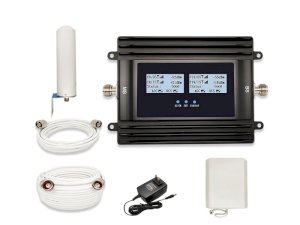
Struggling with weak signals at home or workplace? You might have seen “4G booster no antenna” or “mobile signal booster without external antenna” products, promising an effortless, plug-and-play solution. But do antenna-free 4G boosters work, or are they too good to be true? This helpful UK guide delves into the inner details of both 4G and 5G signal boosters, separating fact from fiction and helping you understand what it really takes to achieve reliable mobile connectivity.
mobile signal booster LCD-300GD
+ FREE Lightning Surge Protector
for United States
4.9/5 — 278 Reviews
Mobile signal woes in the UK for 4G and 5G
Throughout the UK, inconsistent 4G and 5G network coverage is a prevalent problem, both in urban areas and rural environments. Building materials, geographical locations, the distance from your nearest cell tower, and network infrastructure have a noticeable effect on your mobile signal strength. Even weather conditions can sometimes affect the strength of radio waves. This can lead to:
- Sluggish internet speeds. Frustrating delays when surfing the web, streaming videos, or downloading files.
- Dropped calls. Constant interruptions during important conversations, impacting voice calls.
- Unreliable mobile data. Difficulty in using apps that rely on a stable internet connection.
- Missed opportunities. Hampered productivity and communication, both personally and professionally. This is especially critical when needing real-time information.
What is a signal booster and how does it work?
A signal booster, essentially, is designed to take a weak current signal and amplify it, providing more coverage in an area. A typical signal booster system consists of three main components:
- External antenna
This tool, usually mounted externally (on a roof, wall, or window), picks up the weak 4G or 5G signal from nearby cell towers that are owned by mobile network operators like EE, Vodafone, O2, and Three. - Signal amplifier
This component receives the signal from the external antenna and boosts it. The signal amplifier must be able to work with the exact frequency bands your mobile service provider employs for 4G or 5G. - Internal antenna
This antenna retransmits amplified signal within the target area, improving indoor coverage of the signal for your devices like cell phones.
The crucial piece of this system is the external antenna. It receives the initial signal, since without a decent one, there’s simply not much to amplify. This is where the promise of “4G signal booster without external antenna” solutions emerges.
4G and 5G boosters without external antennas: what are they really?
Amplifiers without external antennas are often promoted as simple, hassle-free options, especially for people seeking a home signal booster or an office one. They are usually composed of a small box with built-in antennas that you place in your home or office. The claim is that they can magically boost your 4G or 5G signal without installing an external antenna.
The reality, however, is short of that. These so-called “boosters” are simply internal antennas with small amplification. They can only operate by utilizing an available signal, and their ability to improve coverage is extremely limited. They can’t create a signal where none exists, and their performance is often overstated.
Myth vs. reality: do antenna-free 4G and 5G boosters work?
In fact, “antenna-free” 4G/5G boosters show little to no improvement in signal strength and data speed and are often a waste of money. While they might provide a slight boost in very specific circumstances (placed directly next to a window with a clear line of sight to a cell tower), their effectiveness is severely limited. Below is a list of why say no to these tools:
- They cover a very small area, often just a few feet around the device.
- They require a usable signal to begin with. If you’re in a dead zone, they won’t work. Radio frequency signals have a tendency to lose strength as they travel through the air and pass through obstacles. A small inside antenna simply can’t pick up an ample signal to provide a meaningful boost in most instances.
- The amplification they provide is usually insufficient to overcome signal loss caused by walls, building materials, and distance from the cell tower. The dB gain is typically too low to make a meaningful difference.
Why an external antenna matters in effective signal boosting
An external antenna is the basis of a reliable 4G/5G signal booster system. The reasons are as follows:
- Placed outside, beyond walls and other blockages, it can catch a much stronger and cleaner signal from cell towers.
- It compensates for signal loss based on the material of the building and distance.
- It allows the booster to provide consistent and reliable indoor signal coverage throughout your home or office.
Different types of external antennas
- Directional antennas (Yagi)
These antennas focus on receiving signals from a specific direction. It’s best used when the cell tower location is well known. - Omnidirectional antennas
These antennas receive signals from all directions. They are best for use in places where the cell tower's position is unknown or where signals come from various directions.
Proper installation and positioning of the external antenna are crucial for optimal performance. Placing the external antenna higher results in better signal reception.
The rise of 5G and its effect on signal boosting
5G is the latest generation of mobile technology, with faster data speeds and lower latency. It’s spreading in the UK, but not universally yet. 5G signals are also more prone to being obstructed by buildings and other structures, which might result in poorer indoor signal coverage.
Signal amplifiers will remain on the agenda, but it’s crucial to select a booster that covers the frequency bands employed by your mobile network operator for both 4G and 5G. Some boosters are able to work with both technologies, offering a future-proof solution along with extensive compatibility.
Alternatives to “antenna-free” boosters that actually work
If you truly wish to improve your 4G/5G signal in the UK, consider these alternatives:
-
Wi-Fi calling
Many cell phones and mobile network operators (MNOs) support Wi-Fi calling. This allows you to make and receive phone calls via your Wi-Fi connection. Wi-Fi calling can circumvent the need for cellular signal in some situations and is easy and free to use if you possess good Wi-Fi. -
4G/5G signal boosters with external antennas
As discussed, this is the most reliable way to refine your signal strength. Use an approved booster from a reputable com[any to acquire the best signal boosters. -
Improve your Wi-Fi
Sometimes, the problem isn’t your mobile signal, but your Wi-Fi coverage. Replace your router or add a Wi-Fi extender. -
Switch an MNO
Certain NMOs have better network coverage in some areas than others. Compare coverage maps through Ofcom’s mobile coverage checker and switch to an MNO with a more stable signal at your location. -
Experiment with the location
Try taking your mobile phone to different locations in your home or workspace, especially near windows.
How to choose the right 4G/5G signal booster with an external antenna
If you’ve decided that a signal booster with an external antenna is the right solution for you, here’s what to consider:
- Find out the area you need to cover, the mobile network operators you use, and what frequency bands you need to cover (800 MHz, 1800 MHz, 2600 MHz for 4G; individual 5G bands will vary - consult your provider).
- Observe the gain (dB) of the booster and the frequency bands supported. Make sure it deals with both 4G and 5G frequencies.
- Read reviews and testimonials to see what other users have to say about the booster’s performance.
- Buy from a reliable supplier with a proper warranty and return policy.
Conclusion
While the idea of a “4G signal booster without external antenna” sounds appealing, the reality is that these devices are often ineffective and can be a waste of money. If you’re serious about improving your mobile signal in the UK and want to resolve reception problems, invest in a quality, certified booster with an external antenna. Choose a device that supports both 4G and 5G for future compatibility.










